Laetiporus cincinnatus
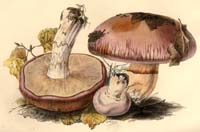 Key to Gilled Mushrooms Key
Key to Gilled Mushrooms KeyThis is a key to gilled mushrooms, that is, mushrooms having a definite cap with a fertile surface consisting of gills. The fruiting body usually also has a stem, although that may be lateral or absent (usually, then, the mushroom is growing from wood). You can use this key to identify mushrooms that you find.
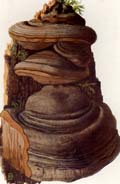 Polyporaceae Family
Polyporaceae FamilyFertile surface usually a layer of vertical tubes, of which the mouths are visible as pores on the underside of the cap or shelf.
Fruiting bodies usually tougher or harder than the "normal" gilled mushrooms, being leathery, corky, or woody. But they can be quite tender while actively growing
Once grown, they do not decay easily, remaining on the substrate for months or years
They often grow on wood, although a few are terrestrial (even those are usually growing on buried wood)
Fruiting body is usually a flat shelf, or hoof-shaped, protruding directly from the substrate, although sometimes it may have a short stalk.
Some forms never grow away from the substrate at all, so that all that is visible of the fruiting body are the pores.
Sometimes the pores are so minute that the fertile surface seems solid, until you look closely
 Lignicopolypore Subfamily
Lignicopolypore SubfamilyGrowing on wood
Sessiloporus TribeNot fitting the other choices, not stipitate
In making choices below based on texture and size, place the emphasis on texture: if left alone, some of the smaller ones can eventually get quite big; and even the huge ones have to start out small at first
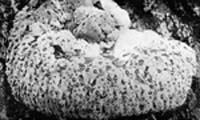 Medium Sessilopolypore Subtribe
Medium Sessilopolypore SubtribeFruiting body medium-sized, soft; shelving, often hairy or velvety when young, becoming smooth in age, often imbricate or compound
Brownish or bright yellow cap surface with (when young) whitish pores
Usually exuding liquid when squeezed or cut; often beaded with droplets on its own
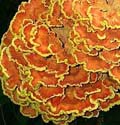 Laetiporus Genus
Laetiporus Genus
Pore surface white or bright yellow
Cap surface somewhat furry when young; usually bright yellow or orange, but may be a pink or brownish plum color
Laetiporus cincinnatus
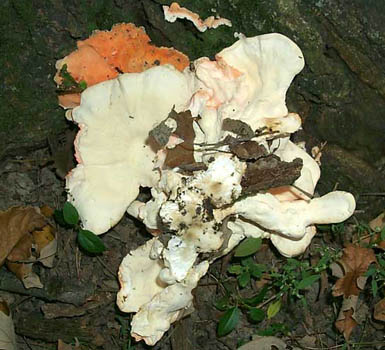 Here are the characters that distinguish this species from the others in its group. For its more general characters, see higher up on the page.
Here are the characters that distinguish this species from the others in its group. For its more general characters, see higher up on the page.
If there's just a few words or a microscopic feature here, a more thorough description can be found above.
Diagnosis
- Pinkish cap surface; white pore surface
-
Growing in rosettes at the base of trees, usually oaks
-
Both colors bright when fresh, fading quickly
Comments
In contrast to the "normal" chicken mushroom, Laetiporus sulphureus, the entire fruiting body of this fungus is usually soft enough to be eaten.
The picture of "Laetiporus persicinus" in A. E. Bessette, D. W. Fischer & A. R. Bessette (1997) is actually Laetiporus cincinnatus, and an excellent picture of it.

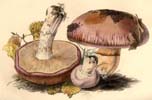


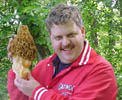

 Key to Gilled Mushrooms Key
Key to Gilled Mushrooms Key Polyporaceae Family
Polyporaceae Family Medium Sessilopolypore Subtribe
Medium Sessilopolypore Subtribe Laetiporus Genus
Laetiporus Genus
 Here are the characters that distinguish this species from the others in its group. For its more general characters, see higher up on the page.
Here are the characters that distinguish this species from the others in its group. For its more general characters, see higher up on the page.




